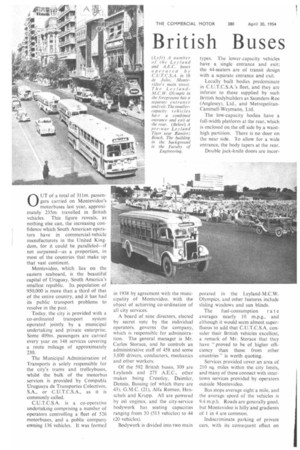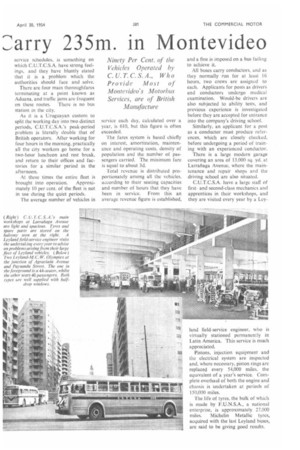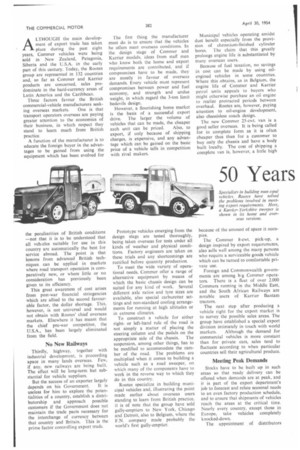British Buses arry 235m. in Montevideo
Page 124

Page 125

Page 126

If you've noticed an error in this article please click here to report it so we can fix it.
0 UT of a total of 311m. passengers carried on Montevideo's motorbuses last year, approximately 235m. travelled in British vehicles. This figure reveals, as nothing else can, the increasing confidence which South American operators have in commercial-vehicle manufacturers in the United K ingdom, for it could be paralleled—if
not surpassed as a proportion, in most of the countries that make up that vast continent.
Montevideo, which lies on the eastern seaboard, is the beautiful capital of Uruguay, South America's smallest republic. Its population of 950,000 is more than a third of that of the entire country, and it has had its public transport problems to resolve in the past.
Today, the city is provided with a co-ordinated transport system operated jointly by a municipal undertaking and private enterprise. Some 409m, passengers are carried every year on 148 services covering a route mileage of approximately 230.
The Municipal Administration of Transports is solely responsible for the city's trams and trolleybuses, whilst the bulk of the motorbus services is provided by Compaflia Uruguaya de Transportes Colectivos, S.A., or C.U.T.C.S.A., as it is commonly called.
C.U.T.C.S.A. is a co-operative undertaking comprising a number of operators controlling a fleet of 526 motorbuses, and a public company owning 136 vehicles. It was formed in 1938 by agreement with the municipality of Montevideo, with the object of achieving co-ordination of all city services.
A board of nine directors, elected by secret vote by the individual operators, governs the company, which is responsible for administration. The general manager is Mr. Carlos Storace, and he controls an administrative staff of 458 and some 3,600 drivers, conductors, mechanics and other workers.
Of the 592 British buses, 309 are Leylands and 275 A.E.C., other makes being Crossley, Daimler, Dennis, Bussing (of which there are 43), G.M.C. (21), Alfa Romeo, Henschels and Krupp. All are powered by oil engines, and the city-service bodywork has seating capacities ranging from 30 (513 vehicles) to 44 (20 vehicles).
Bodywork is divided into two main types. The lower-capacity vehicles have a single entrance and exit; the 44-seaters are of transit design with a separate entrance and exit.
Locally built bodies predominate in C.U.T.C.S.A.'s fleet, and they are inferior to those supplied by such British bodybuilders as Saunders-Roe (Anglesey), Ltd., and MetropolitanCammell-Weymann, Ltd.
The low-capacity bodies have a full-width platform at the rear, which is enclosed on the off side by a waisthigh partition. There is no door on the near side. To allow for a wide entrance, the body tapers at the rear.
Double jack-knife doors are incor porated in the Leyland-M.C.W. Olympics, and other features include sliding windows and sun blinds.
The fuel-consumption rate averages nearly 10 m.p.g., and although it would seem almost superfluous to add that C.U.T.C.S.A. consider their British vehicles excellent, a remark of Mr. Storace that they have " proved to be of higher efficiency than those from other countries" is worth quoting.
Services provided cover an area of 210 sq. miles within the city limits, and many of these connect with intertown services provided by operators outside Montevideo.
Bus stops average eight a mile, and the average speed of the vehicles is 9.4 m.p.h. Roads are generally good, but Montevideo is hilly and gradients of 1 in 4 are common.
Indiscriminate parking of private cars, with its consequent effect on
service schedules, is something on which C.U.T.C.S.A. have strong feelings, and they have bluntly stated that it is a problem which the authorities should face and solve.
There are four main thoroughfares terminating at a point known as Aduana. and traffic jams are frequent on these routes. There is no bus station in the city.
As it is a Uruguayan custom to split the working day into two distinct periods, C.U.T.C.S.A.'s peak-period problem is literally double that of British operators. After working for four hours in the morning, practically all the city workers go home for a two-hour luncheon and rest break, and return to their offices and factories for a similar period in the afternoon.
At these times the entire fleet is
brought into operation. Approximately 10 per cent. of the fleet is not in use during the quiet periods.
The average number of vehicles in service each day, calculated over a year, is 610, but this figure is often exceeded.
The fares system is based chiefly on interest, amortization, maintenance and operating costs, density of population and the number of passengers carried. The minimum fare is equal to about 3d.
Total revenue is distributed proportionately among all the vehicles, according to their seating capacities and number of hours that they have been in service. From this an average revenue figure is established, and a fine is imposed on a bus failing to achieve it.
All buses carry conductors, and as they normally run for at least 16 hours, two crews are assigned to each. Applicants for posts as drivers arid conductors undergo medical examination. Would-be drivers are also subjected to ability tests, and previous experience is investigated before they are accepted for entrance into the company's driving school.
Similarly, an applicant for a post as a conductor must produce references, which are closely checked, before undergoing a period of training with an experienced conductor.
There is a large modern garage covering an area of 13,000 sq. yd. at Larrafiaga Avenue, where the maintenance and repair shops and the driving school are also situated.
C.U.T.C.S.A. have a large staff of firstand second-class mechanics and apprentices in their workshops, and they are visited every year by a Ley land field-service engineer, who is virtually stationed permanently in Latin America. This service is much appreciated.
Pistons, injection equipment and the electrical system are inspected and, where necessary, piston rings are replaced every 54,000 miles, the equivalent of a year's service. Complete overhaul of both the engine and chassis is undertaken at periods of 150,000 miles.
The life of tyres, the bulk of which is made by F.U.N.S.A., a national enterprise, is approximately 27,000 miles. Michelin Metallic tyres, acquired with the last Leyland buses, are said to be giving good results.
ALTHOUGH the main development of export trade has taken place during the past eight years, Commer vehicles were being sold in New Zealand, Patagonia, Siberia and the U.S.A. in the early part of this century. Today, the Rootes group are represented in 132 countries and, so far as Commer and Karrier products arc concerned, sales predominate in the hard-currency areas of Latin America and the Caribbean.
Three factors favour the British commercial-vehicle manufacturers seek ing overseas markets. One is that transport operators overseas are paying greater attention to the economics of their business, in which respect they stand to learn much from British practice.
A function of the manufacturer is to educate the foreign buyer in the advantages to be gained from using the equipment which has been evolved for The first thing the manufacturer must do is to ensure that the vehicles he offers meet overseas conditions. In the design stage of Commer and Karrier models, ideas from staff men who know both the home and export requirements are contributed, and if compromises have to be made, they are mostly in favour of overseas demands. Every vehicle must represent compromises between power and fuel economy, and strength and undue weight, in which regard the 3-ton limit bedevils design.
However, a flourishing home market is the basis of a successful export drive. The larger the volume of vehicles that can be made, the cheaper each unit can be priced. Also, to export, if only because of shipping charges, is expensive, and any advantage which can be gained on the basic price of a vehicle tells in competition with rival makers. Municipal vehicles operating amidst dust benefit especially from the provision of chromium-finished cylinder bores. The claim that this greatly prolongs engine life is substantiated by many overseas users.
Because of fuel taxation, no savings in cost can be made by using oilengined vehicles in some countries. Where this obtains, as in Belgium, the engine life of Commer and Karrier petrol units appeals to buyers who might otherwise purchase an oil engine to realize protracted periods between overhaul. Rootes arc, however, paying attention to oil-engine development, also chassisless coach design.
The new Commer 25-cwt. van is a good seller overseas. It is being called for in complete form as it is often cheaper thus than for a customer to buy only the chassis and have a body built locally. The cost of shipping a complete van is; however, a little high




















































































































































































































































